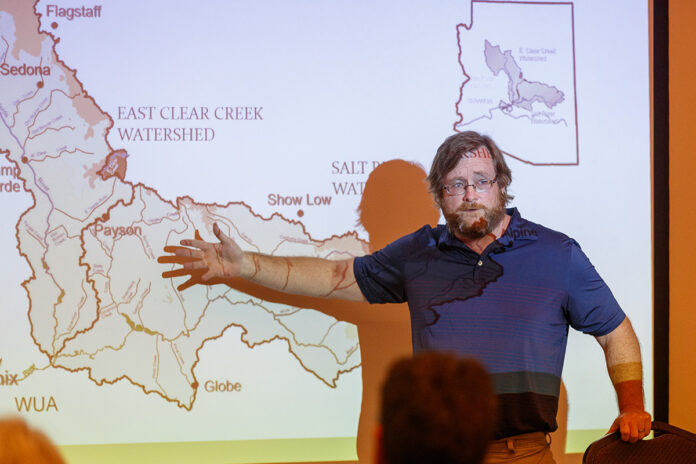The Verde Natural Resource Conservation District held a water adjudication workshop at the Camp Verde Community Library on Friday, Oct. 6.
A surface water right is required to divert and use surface water in Arizona, including water from rivers, streams, washes, lakes, springs and some underground water drawn from a well.
Water rights in Arizona have not yet been fully adjudicated, and until the process is complete, uncertainty remains about a property’s water right. Currently, water users can claim a surface water right associated with their property.
The Verde River is in the process of being adjudicated through the Gila River Adjudication conducted by the Maricopa County Superior Court. This proceeding involves around 90,000 claims by roughly 24,000 parties.
A general stream adjudication is the judicial determination of the source, extent and priority of water rights in a river system.
Carter Benton of the Salt River Project discussed the history of the program and its current status during the workshop. A state water use agency and public power utility, SRP was formed in 1903 by farmers and developed into a power business that now provides electricity to farmers and the Phoenix metro area.
Benton made the argument that all western states need adjudication and that it provides a greater certainty to all water users. He walked attendees through the adjudication process, which includes the preparation of hydrographic survey and watershed file reports, contested cases, the water rights catalog and a final decree.
Oral arguments about the Verde River mainstem subflow took place in September. A Verde tributaries subflow report will be created and objections due by the end of October, followed by a de minimis trial tentatively set for July 2024 to determine if a summary adjudication is warranted.
Hydrographic survey reports for the Sycamore subwatershed and the Lower Verde Valley subwatershed will be completed in 2026 and 2027. Benton said that claimants should have their claims documented by that time.
Kim Schoneck of The Nature Conservancy presented information on different websites that landowners can use to learn about adjudication and filing a claim.
“This only works if everybody knows what water they have and we can start to have a conversation to make sure we have water in the future,” Schoneck said. These websites included the Arizona Water Blueprint site, which provides interactive maps with different layers that enable users to see what ditch they’re on, what subflow zone they are in and what wells exist on their property, and the Arizona Department of Water Resources website, which has recently added more data and maps, including a claimant locator map.
“You’re all in this together,” Schoneck said. “The most impact happening with your water right is happening upstream of you where it can be diverted before it gets to you.”
Rachel Cook, supervisor of the adjudications division at ADWR, explained ADWR’s role in the process and how to complete a statement of claimant form.
ADWR provides technical assistance to the court by issuing new use summons, accepting filings, amendments and assignments of statements of claimants and investigating and reporting on water use as directed by the court.
Cook explained that anyone who uses or has used water for anything within an adjudicated watershed can file an SOC to participate in the adjudication proceedings.
The filing of an SOC serves as an official claim to a water right and enters the claim into the adjudication proceedings. Cook clarified that an SOC is not itself a water right.
There are four different SOC forms for stock ponds, domestic use, irrigation and other uses. Detailed instructions for filling out the forms can be found on the ADWR website.
Cook added that property owners might already have an SOC associated with their property and should check before filing, which can be done using an interactive map on ADWR’s site.
Each form requires a basis for the claim, which is the method by which the water right was established; a claimed priority date, which is the date when water was first used beneficially; a claimed right, which is the amount of water used annually; and a place of use, which is the location from which the water is diverted.



